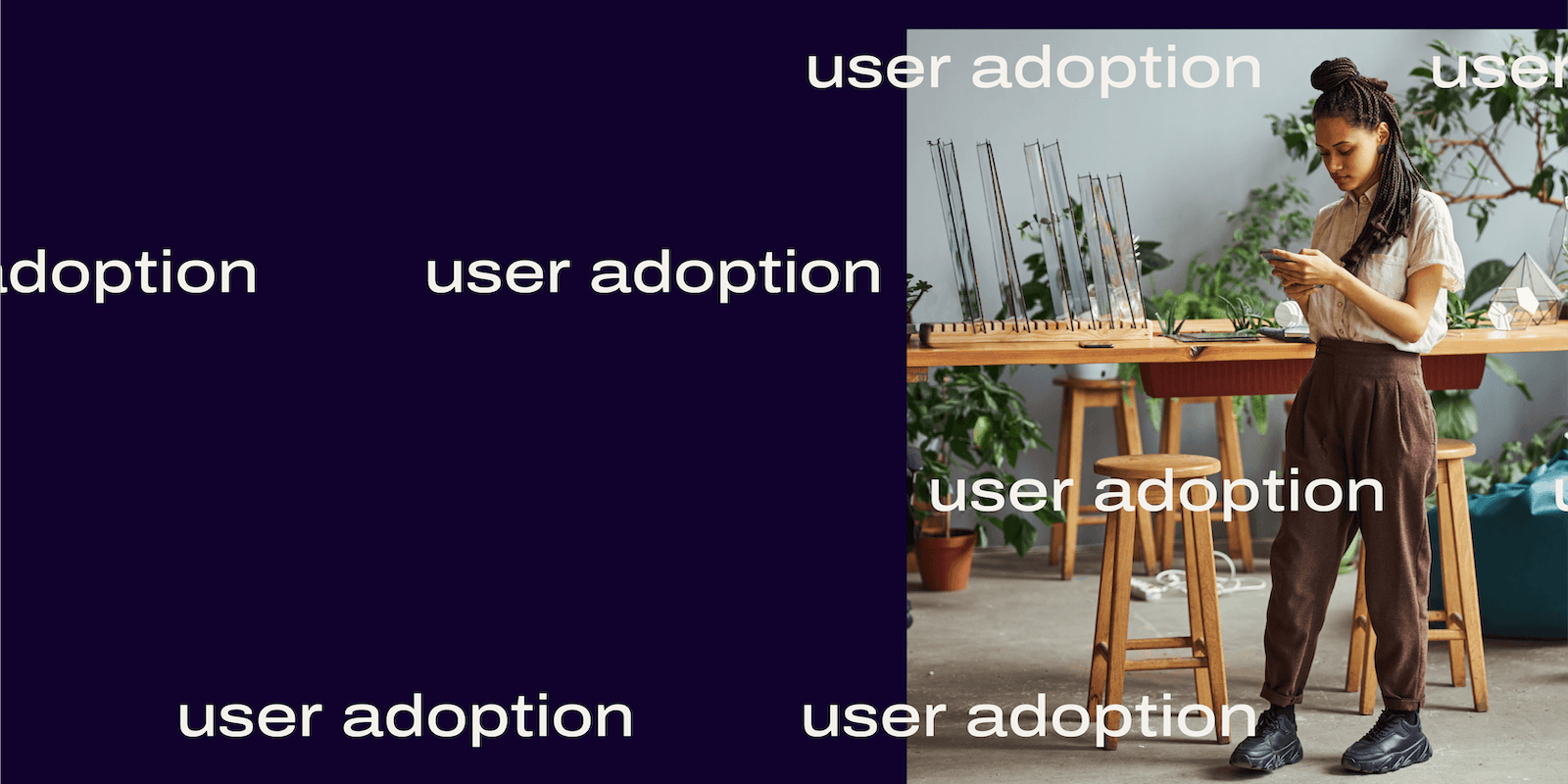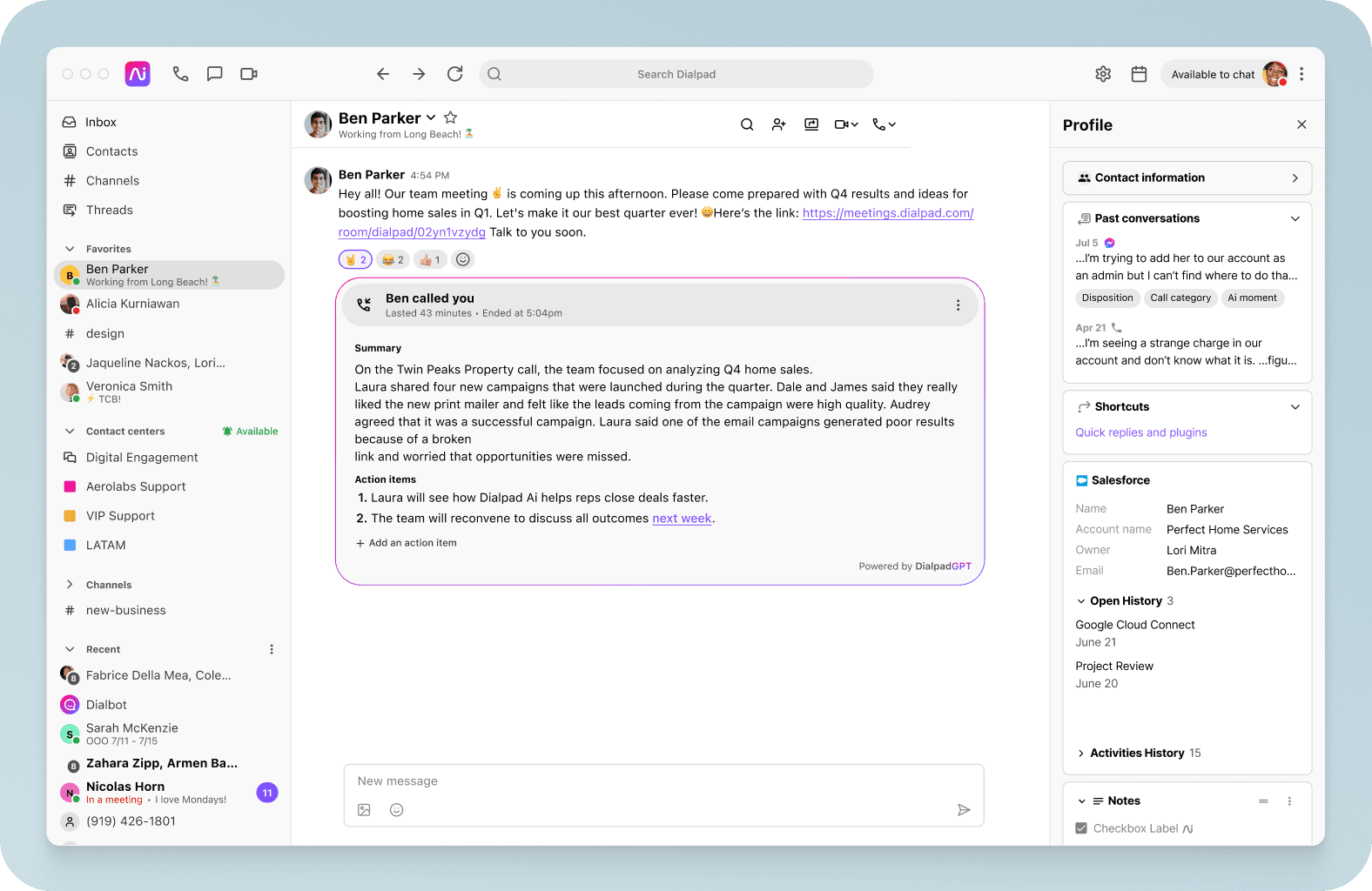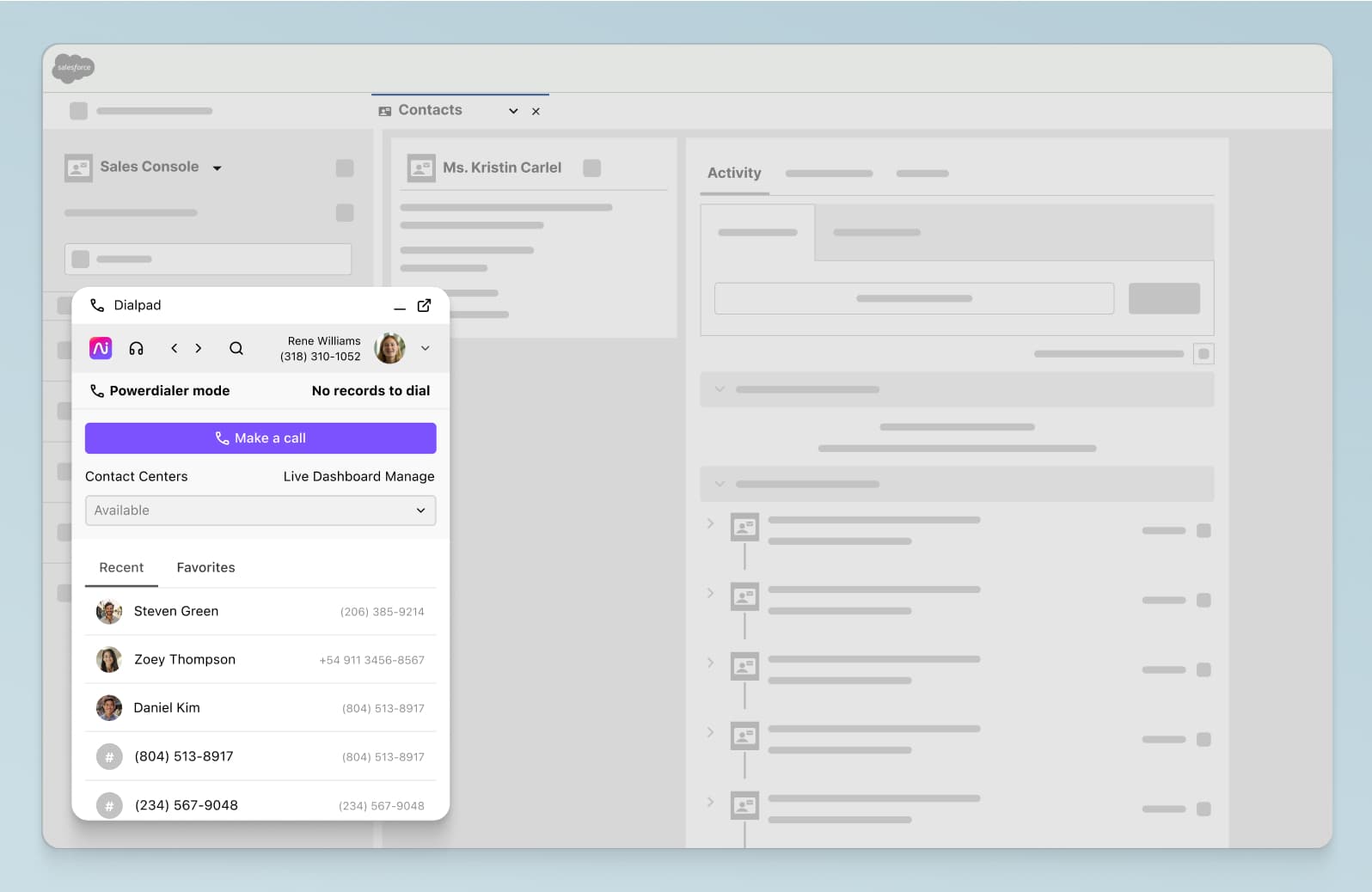
Tags
Share
If you work at a company that’s building a software or app, one of the biggest challenges after you’ve made the sale (which is itself another fun challenge) is user adoption. Or, getting your new customers to actually use your tool regularly after they’ve given you their credit card information.
But there are many roadblocks to user adoption that teams have to overcome. From rollout processes that are too difficult to get started with to poorly designed user interfaces, the pitfalls can seem insurmountable.
In this blog post, we’ll look at how to improve user adoption and show you some tactics we use ourselves—since hey, we’re building technology here too.
What is user adoption?
User adoption is the process new customers or end users go through when they start using a new product and (hopefully) commit to it long term.
They may be shopping around for a new product that's more effective at helping them achieve specific goals. But once they give it a try, they're only going to commit if the product proves useful and helps them achieve said goals.
Independent media agency, Mediasmith, knows a thing or two about committing to a new product. As support costs for their business phone system grew, they started looking for a better option. To help with adoption, they made sure their new communications platform had intuitive features, was easy to use and admin, and had native integrations with the tools that the team was already using.
"Dialpad's integration with Office 365 allowed us to leverage Microsoft's Azure directory to manage our users. So onboarding new users would be much easier," said Stanley Fukuda, their Systems and Technology Manager. And easier onboarding + better user adoption = goals achieved.
The user adoption process is critical for all businesses, but it's monumentally important for SaaS companies that rely on recurring revenue. If a user jumps ship, so does their money.
The benefits of high user adoption for businesses
Encourages user growth
One of the biggest benefits of having a user adoption strategy is it encourages and strengthens customer engagement and growth.
Customers don't go from new users to long-term adopters overnight. You may know your products’ different use cases well, but they likely don’t! The user experience is a multi-level journey through several phases, and user adoption is one of the most fundamental parts.
If a customer falters in adopting your product, how can they be expected to grow with it? Progressive user growth means you've implemented a strong foundation. And a strong foundation means you've got a better chance at an ongoing customer relationship peppered with recurring earnings.
Reduces customer churn
Customers tend to churn when they don't realize the value they imagined they'd get from a product. With the right analysis tools, you'll be able to spot when they start to lose interest in the product.
For example, with Dialpad, you can use call analytics to see how your customers feel with sentiment analysis. If you find that negative sentiment is increasing on calls, you can dig into specific call recordings and transcripts to better understand the trends and develop a solution:

High user adoption can help reduce customer churn because it if your user onboarding is successful and your customers can easily start using your product from day one, they'll be able to work it into their workflows sooner and make it part of their routine (which lowers the chance that they'll just drop off and churn because they realize that they're not really using your software).
Another benefit of reducing customer churn? You're more likely to save on retention costs. Staffing a customer success team and developing customer training programs to continuously educate customers is expensive. Focusing on initial user adoption can help you save costs down the road.
High CLV (customer lifetime value)
CLA is a useful metric to track because it lets you see how much you're spending on each user that commits to your product, and the value of that customer over their relationship with your business. It can help you see how product adoption affects sales and show you where you need to finetune your marketing efforts.
Because high user adoption lowers churn, by extension it can also help you increase your Customer Lifetime Value (CLV). This means better CLV numbers, and less money you'll have to spend on acquiring new customers.

Metrics and KPIs to monitor and focus on for user adoption
You don't need to play a guessing game when it comes to understanding the effectiveness of your user adoption strategy.
Here are a few metrics and KPIs to monitor that can show you the ins and outs of your user adoption rates, so you can make more data-driven decisions.
Product adoption rate
This metric determines the popularity of your product among new customers. By calculating the product adoption rate, you can see how many of your new customers have embraced the product and routinely use it.
Formula: New active users ÷ total sign ups x 100
Time to first key action
Measuring the time it takes a customer to achieve their first key action can show you two things. It can show you how fast users are adopting your product, or it can show you how much time they're spending without adopting your product.
How you choose to interpret this metric is up to you and your user adoption strategy. Determine what your key actions are; maybe product purchase or full product implementation.
Formula: Calculate the average amount of days from signing up to the first key action.
Daily/monthly active users
Tallying up the raw number of daily or monthly users you have isn't very specific, but it can help you understand the number of active users you have for any given period. It allows you to roughly determine product adoption, but luckily, there's a better metric you can utilize: The percentage of daily and monthly active users.
Calculating the percentage of daily or monthly active users lets you see an actual number for the existing users that have adopted your product and are engaging with it during a specific period.
Formula: Daily or monthly active users ÷ total users x 100
Average time spent with product
This metric is pretty straightforward—it measures the time spent interacting with your product. Average time spent can help you understand how many users are employing your product and what different levels of adoption look like.
Formula: Total session duration ÷ total number of sessions
Average use frequency
Average use frequency calculates how frequently an average user uses your product, and it can help you understand the adoption of your product in more detail.
Formula: The number of uses of a product ÷ the time it took for each use to occur
Net promoter score
Net promoter score (NPS) is a KPI you definitely want to track. NPS helps you see what percentage of customers would recommend your product to other people. With the assumption that not only have they adopted its use, but also that they’re highly satisfied, too.
NPS measures the satisfaction of all your customers, so it gives you an excellent opportunity to engage with customers that have different scores and adapt user adoption strategies.
Formula: Survey customers and see how likely they are to recommend your product on a scale of 0-10. Detractors will score between 0-6, passives between 7-8, and promoters between 9-10.
Subtract the percentage of detractors from the percentage of promoters to see your overall NPS score:

7 essential strategies for user adoption
Now that we've gone over the benefits of user adoption and the metrics you want to use to track it, let's get into the strategies that help you piece everything together.
1. Establish SMART goals
There are smart goals, and then there are SMART goals. Here's a quick breakdown:
Specific: Make your goal specific for effective planning.
Measurable: Define goal perimeters so you can measure progress and re-evaluate when you need to.
Achievable: Set a reasonable timeframe to accomplish your goal.
Realistic: Your goal should align with your long-term objectives.
Timely: set a realistic end date to motivate yourself and prioritize tasks.
Set an overall SMART goal for your user adoption strategy, like decreasing the amount of time to a customer's first key action by a specific date. SMART goals can help you map out each specific goal you want to achieve for user adoption and put you on the right path to getting there.
2. Provide clear product education
Learning anything new takes time. Unfortunately, if barriers exist that make learning a new product difficult, users may abandon your product in favor of doing things the same old way.
This is where clear product education can play an important role in reducing churn rates and preventing user drop-off. Use product analytics and the metrics we discussed earlier to review your onboarding funnel to see where the most problems occur.
The good news is you can easily pick up on customer pain points pretty easily when you have insights that come right from the customer. Dialpad analytics link directly into call history, straight from your account (you don't have to submit any tickets or requests and wait for a provider to give you this data) with readable call transcripts and key moments so you can analyze customer calls.
With Dialpad, we can find out exactly where our customers' pain points are by tracking keywords:

👉 Dialpad tip:
Once you've added filter criteria, the URL is unique and bookmarkable. Bookmark the URL from your web browser, and you can return to it in the future.
Optimize weak points with walkthrough animations, onboarding videos, and navigation to FAQs and customer help portals. Don't bombard users with pop-ups and transition animation—just make sure there's enough content for success. Consider integrating animation apps to enhance progress bars and onboarding checklists, ensuring users have a clear and engaging view of their onboarding journey.
3. Have a customer success team
Customer success teams are an essential part of a good user adoption strategy, because unlike customer support teams, which are there to help customers with problems, customer success teams are there to make sure your customers are successful with your product.
In other words, they’re a proactive piece (and key stakeholders!) of your user adoption strategy. Most often your customer success team should be using tools like CRM systems to keep track of customers and their relationship history with your company.
One useful thing about Dialpad, for example, is that it integrates with CRMs like Salesforce and HubSpot. The integration’s main function is to streamline workflows for agents and let them take phone calls from right inside the CRM:

Not only that, the automation will log activities and calls made with Dialpad right into the CRM—even voicemails and full call transcripts are captured—without the agent needing to lift a finger.
If any new customers do have issues or questions getting started, any agent can easily get a full overview of their past questions and conversations, and help them more effectively.
4. Reduce adoption friction
The best way to move customers through the onboarding process is to have as little friction as possible from day one of use. The more friction they run into, the more likely they'll be to abandon your product.
Stick to the usual accepted design elements for the onboarding user experience. If the process looks unfamiliar from the beginning, users will become frustrated more easily. If it seems like something they've used before, it will require less learning on their part, allowing them to focus on critical onboarding information.
St. Charles Automotive was looking for ways to improve its infrastructure and be more productive. They decided to employ Dialpad, and to their delight, they experienced a frictionless onboarding experience. In just one day of deploying Dialpad, over 95% of the staff became power users.
Kevin Maher Jr., their general manager said, "By far, we've had the best go-live and onboarding experience with Dialpad. From user adoption to the ability to adapt from a legacy phone system, I can't express how smooth this transition has been."
5. Have a good customer onboarding plan
Customer onboarding is an essential step in the customer journey. It mainly pertains to a first-time customer's initial sign-up, product activation, and first few days of product use. Succeeding in these early days is critical for long-term, successful user adoption.
The critical objective in customer onboarding is to keep the customer engaged and committed to using your product as they integrate it into their existing routines. Here's a basic rundown of the essential elements:
The flow of signing up
The first welcome email
First login experience
Adding integrations and other users
Product walkthroughs and tutorials
Follow-up emails
Optimizing a continuous customer onboarding experience will make it easier for new customers to learn the product's system and find the business value in their purchase.
6. Offer a trial period
Free trial periods are a great way to introduce new users to your product so they can see how it actually works for them. Trial users can get a chance to experience all the product has to offer and see what it can do for them, before committing to any substantial subscriptions.
For example, a prospective customer may have heard about a new feature of your product that they're interested in, but they're not going to get really excited until they see how it works IRL with their other business processes.
Offering a trial period, free or otherwise, may not suit your particular product, but if you have low user adoption rates, seriously consider it as a possible strategy.
7. Continuously monitor, measure, and optimize
Continuous monitoring, measurement, and adjustment can help you make sure you're providing the absolute best user journey possible. Customer monitoring can make sense of customer data letting you turn the insights into actions that deliver.
Monitoring and measuring can also reveal patterns in feature access, time spent in the product, or bottlenecks so you can adjust initial onboarding. Besides giving you a baseline to work from, monitoring, measuring, and adjusting can also show you the impact of the changes you're making.
This gives you an invaluable guide into any future actions you decide to implement.
Optimize user adoption strategies and improve customer acquisition and retention
Getting someone to adopt new technology or a new system, especially if it’s a particularly innovative or uncommon type of technology, can be a significant challenge if you don’t have a systematic plan.
You have to know how to track and measure your user adoption strategy, and for many SaaS businesses, improving is going to be a continuous process. But the results are well worth the effort. Increased user retention and revenue expansion will help you grow your business with dedicated customers that won't quit you.
Looking for a well-designed communications platform—that your team will actually use?
Take Dialpad's unified communications platform for a spin with a 14-day free trial! It takes just a few minutes to get set up, and you'll get a virtual phone number too. Or, take a self-guided interactive tour of the app first!









